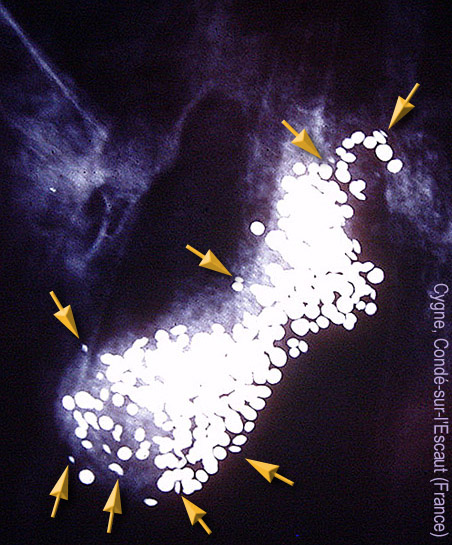File:1plombs chasse cygne condé2.jpg
頁面內容不支援其他語言。
外觀
1plombs_chasse_cygne_condé2.jpg (452 × 545 像素,檔案大小:105 KB,MIME 類型:image/jpeg)
摘要
| 描述1plombs chasse cygne condé2.jpg |
English: Radiography of a swan found dead in Condé-sur-l'Escaut (North of France), highlighting a large number of lead shot from hunting cartridge, and ingested with the Grit. The swans that feed in front of hunters's huts or in front of shooting positions are very frequently victim of "waterfowl lead poisoning". Here the number of lead is exceptionally high (some hundreds), and caused the death of the animal (12 small lead pellets are enough to kill an adult swan within a few days. The poisoned swans were also more likely to collide with an obstacle (power line, for example) or vehicle. Their body will be a new source of environmental contamination of toxic lead. It is noted that a new swan population has recovered in the late 1990s in the marsh audomarois, but it feeds mainly on land, which is a source of conflict with the gardeners who cultivate drained areas and emergent marsh (Is this an adaptive behavior, the result of natural selection, with the appearance of a new behavior limiting the risk of ingesting lead pellets)
It should be noted that the occurrence and prevalence of lead poisoning avian sontplus higher in Europe and North America where they were first studied. See data collected by RAFAEL MATEO (Instituto de Investigación en Recursos Cinegéticos IREC, CSIC, UCLM, JCCM) for his presentation WILD BIRDS IN Lead Poisoning IN EUROPE AND THE REGULATIONS ADOPTED BY DIFFERENT COUNTRIES upon Conference entitledIngestion of Spent Lead Ammunition; Implications for Wildlife and Humans (organized by the "Peregrine Fund" (Boise State University Idaho. May 12-15, 2008). Proceedings of the conference, which led to the book: [https: / / www.createspace.com / 3382279 Ingestion of Spent Lead Ammunition from: Implications for Wildlife and Humans, co-written by Richard T. Watson, Mark Fuller, Mark Pokras, Grainger Hunt] 2009/04/28; ISBN/EAN13: 0961983957 / 9780961983956, 394 pages.
Français : Radiographie d'un cygne trouvés morts à Condé-sur-l'Escaut (Nord de la France) mettant en évidence un grand nombre de grenaille de plomb, provenant de cartouche de chasse, et ingérées avec le grit. Les cygnes mangeant devant les huttes de chasse ou devant des postes de tirs très utilisés sont fréquemment victime du saturnisme. Ici le nombre de plomb est exceptionnellement élevé, et a causé la mort de l'animal. 12 billes de plomb suffisent généralemnt à tuer un cygne adulte en quelques jours. Les cygnes intoxiqués ont également plus de risque d'entrer en collision avec un obstacle (ligne à haute tension par exemple) ou un véhicule. Leur cadavre sera une nouvelle source de contamination environnementale. Il est à noter qu'une nouvelle population de cygnes s'est reconstitué à la fin des années 1990 dans le marais Audomarois (plus de 250 oiseaux vers 2008 selon la presse locale) , mais qu'elle se nourrit essentiellement sur terre, ce qui est source de conflit avec les maraichers qui cultivent les zones drainées et émergées du marais (voir Article Voix du Nord, du Jeudi 2009/10/08, de Nicolas Faucon, intitulé "À Saint-Omer, ulcéré par les dégâts commis par les cygnes, un maraîcher assigne l'État")(S'agit il d'un comportement adaptatif, issu d'une sélection naturelle, avec apparition d'un nouveau comportement limitant le risque d'ingestion de billes de plomb). Les flèches jaunes montrent des grains de plomb déjà très érodés. Il est possible que d'autres grains (totalement érodés et donc non visible sur cette radiographie) aient été antérieurement avalés par le cygne. Ici l'animal a du mourir en quelques jours, d'une intoxication aiguë (avec une agonie probablement très douloureuse, si l'on se rapporte à ce qu'on connait des symptômes du saturnisme chez l'Homme). Il est à noter que l'occurrence et la prévalence du saturnisme aviaire sont plus élevés en Europe qu'en Amérique du nord où ils ont d'abord été étudiés. Cf. données collectées par RAFAEL MATEO (Instituto de Investigación en Recursos Cinegéticos IREC ; CSIC, UCLM, JCCM) pour son exposé LEAD POISONING IN WILD BIRDS IN EUROPE AND THE REGULATIONS ADOPTED BY DIFFERENT COUNTRIES lors de la Conférence intitulée Ingestion of spent lead ammunition ; Implications for wildlife and humans (organisée par le "Peregrine fund" (Boise state University, Idaho. 12-15 mai 2008). Actes de la conférence, qui ont donné lieu à l'ouvrage : Ingestion of Lead from Spent Ammunition: Implications for Wildlife and Humans, co-écrit par Richard T. Watson, Mark Fuller, Mark Pokras, Grainger Hunt 2009/04/28 ; ISBN/EAN13:0961983957 / 9780961983956 ; 394 pages. |
| 日期 |
約1990年 date QS:P,+1990-00-00T00:00:00Z/9,P1480,Q5727902 |
| 來源 | 自己的作品 |
| 作者 | Lamiot |
授權條款
我,本作品的著作權持有者,決定用以下授權條款發佈本作品:

|
已授權您依據自由軟體基金會發行的無固定段落、封面文字和封底文字GNU自由文件授權條款1.2版或任意後續版本,對本檔進行複製、傳播和/或修改。該協議的副本列在GNU自由文件授權條款中。http://www.gnu.org/copyleft/fdl.htmlGFDLGNU Free Documentation Licensetruetrue |
- 您可以自由:
- 分享 – 複製、發佈和傳播本作品
- 重新修改 – 創作演繹作品
- 惟需遵照下列條件:
- 姓名標示 – 您必須指名出正確的製作者,和提供授權條款的連結,以及表示是否有對內容上做出變更。您可以用任何合理的方式來行動,但不得以任何方式表明授權條款是對您許可或是由您所使用。
- 相同方式分享 – 如果您利用本素材進行再混合、轉換或創作,您必須基於如同原先的相同或兼容的條款,來分布您的貢獻成品。
您可以選擇您需要的授權條款。
說明
添加單行說明來描述出檔案所代表的內容
在此檔案描寫的項目
描繪內容
創用CC姓名標示-相同方式分享1.0通用版 繁體中文 (已轉換拼寫)
創用CC姓名標示-相同方式分享2.0通用版 繁體中文 (已轉換拼寫)
創用CC姓名標示-相同方式分享2.5通用版 繁體中文 (已轉換拼寫)
image/jpeg
107,464 位元組
545 像素
452 像素
檔案歷史
點選日期/時間以檢視該時間的檔案版本。
| 日期/時間 | 縮圖 | 尺寸 | 使用者 | 備註 | |
|---|---|---|---|---|---|
| 目前 | 2010年5月24日 (一) 09:59 |  | 452 × 545(105 KB) | Lamiot | {{Information |Description={{en|1=Radiography of a swan found dead in Condé-sur-l'Escaut (North of France), highlighting a large number of lead shot from hunting cartridge, and ingested with the Grit. The swans that feed in front of hunter |
檔案用途
下列頁面有用到此檔案:
全域檔案使用狀況
以下其他 wiki 使用了這個檔案:
- en-two.iwiki.icu 的使用狀況
- en.wikiversity.org 的使用狀況
- fr.wikipedia.org 的使用狀況
- id.wikipedia.org 的使用狀況
- ko.wikipedia.org 的使用狀況
- pl.wikipedia.org 的使用狀況
詮釋資料
隱藏分類:


